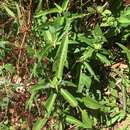fr
noms dans le fil d’Ariane


Commelina virginica, commonly known as the Virginia dayflower, is a perennial herbaceous plant in the dayflower family. It is native to the mideastern and southeastern United States, where it is typical of wet soils. While most members of the genus have thin, fibrous roots, the Virginia dayflower is relatively unique for its genus in having a perennial rhizome. The plant was first described by Carl Linnaeus in his 1762 publication of the second edition of Species Plantarum.[2] A phylogenetic study based on the nuclear ribosomal DNA region 5S NTS and the chloroplast region trnL-trnF, two commonly used gene regions for determining relationships, suggested that Commelina virginica is most closely related to two African species, namely Commelina capitata and Commelina congesta. However, the statistical support for this result was low. Morphologically speaking the supposedly related species do share some unique traits. C. virginica and C. capitata have red hairs at the top of their leaf sheaths, an unusual character in the genus, while C. virginica and C. congesta both have clustered inflorescences on very short stalks.[3]
Commelina virginica, commonly known as the Virginia dayflower, is a perennial herbaceous plant in the dayflower family. It is native to the mideastern and southeastern United States, where it is typical of wet soils. While most members of the genus have thin, fibrous roots, the Virginia dayflower is relatively unique for its genus in having a perennial rhizome. The plant was first described by Carl Linnaeus in his 1762 publication of the second edition of Species Plantarum. A phylogenetic study based on the nuclear ribosomal DNA region 5S NTS and the chloroplast region trnL-trnF, two commonly used gene regions for determining relationships, suggested that Commelina virginica is most closely related to two African species, namely Commelina capitata and Commelina congesta. However, the statistical support for this result was low. Morphologically speaking the supposedly related species do share some unique traits. C. virginica and C. capitata have red hairs at the top of their leaf sheaths, an unusual character in the genus, while C. virginica and C. congesta both have clustered inflorescences on very short stalks.
Commelina virginica es una planta perenne herbácea de la familia Commelinaceae.
Es nativa del este de Estados Unidos. Prefiere suelos húmedos.
Se diferencia de otras especies de este género porque tiene rizomas perennes. En su lugar de origen florece de julio a septiembre. Las flores son hermafroditas, con tres pétalos azules.
La planta fue descripta por Lineo en 1762 en la segunda edición de Species Plantarum.[1]
Puede resistir más de 6 L de glifosato 48 %.[3]
Commelina virginica es una planta perenne herbácea de la familia Commelinaceae.
Commelina virginica là một loài thực vật có hoa trong họ Commelinaceae. Loài này được L. mô tả khoa học đầu tiên năm 1762.[1]
Commelina virginica là một loài thực vật có hoa trong họ Commelinaceae. Loài này được L. mô tả khoa học đầu tiên năm 1762.
耳苞鸭跖草(学名:Commelina auriculata),又名蓬莱鸭跖草、耳叶鸭跖草,为鸭跖草科鸭跖草属的植物。分布在大洋洲、印度尼西亚、日本、台湾岛以及中国大陆的澳门、广东、福建等地,见于低海拔的丘陵丛林中或山沟水边,目前尚未由人工引种栽培。
|access-date=中的日期值 (帮助) 耳苞鸭跖草(学名:Commelina auriculata),又名蓬莱鸭跖草、耳叶鸭跖草,为鸭跖草科鸭跖草属的植物。分布在大洋洲、印度尼西亚、日本、台湾岛以及中国大陆的澳门、广东、福建等地,见于低海拔的丘陵丛林中或山沟水边,目前尚未由人工引种栽培。